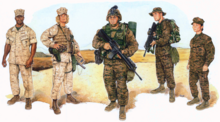Our website is made possible by displaying online advertisements to our visitors.
Please consider supporting us by disabling your ad blocker.
MARPAT
| MARPAT (Marine Pattern) | |
|---|---|
 A swatch of MARPAT-printed fabric in the woodland pattern variant | |
| Type | Military camouflage pattern |
| Place of origin | United States |
| Service history | |
| In service | 2002–present |
| Used by |
|
| Wars | In US service: War in Afghanistan Iraq War In non-US service: Insurgency in Northeast India Naxalite-Maoist Insurgency Insurgency in Jammu and Kashmir Russo-Georgian war Insurgency in Northern Chad Syrian civil war Yemeni civil war Internal conflict in Myanmar (including the Myanmar civil war) Iranian intervention in the Russian invasion of Ukraine |
| Production history | |
| Designer | Timothy O'Neill, Anabela Dugas, Kenneth G. Henley, John Joseph Heisterman, Jr., Luisa DeMorais Santos, Gabriel R. Patricio, Deirdre E. Townes |
| Designed | 2000–2001 |
| Produced | 2001–present |
| Variants |
|

MARPAT (short for Marine pattern)[3] is a multi-scale camouflage pattern in use with the United States Marine Corps, designed in 2001 and introduced from late 2002 to early 2005 with the Marine Corps Combat Utility Uniform (MCCUU), which replaced the Camouflage Utility Uniform. Its design and concept are based on the Canadian CADPAT pattern. The pattern is formed of small rectangular pixels of color. In theory, it is a far more effective camouflage than standard uniform patterns because it mimics the dappled textures and rough boundaries found in natural settings. It is also known as the "digital pattern" or "digi-cammies" because of its micropattern (pixels) rather than the old macropattern (big blobs).
The United States government has patented MARPAT, including specifics of its manufacture.[4] By regulation, the pattern and items incorporating it, such as the MCCUU and ILBE backpack, are to be supplied by authorized manufacturers only and are not for general commercial sale, although imitations are available such as "Digital Woodland Camo" or "Digital Desert Camo".
MARPAT was also chosen because it distinctively identifies its wearers as Marines to their adversaries, while simultaneously helping its wearers remain concealed. This was demonstrated by a Marine spokesman at the launch of MARPAT, who stated: "We want to be instantly recognized as a force to be reckoned with. We want them to see us coming a mile away in our new uniforms."[5] As such, the U.S. Marine Corps restricts use of the camouflage, preventing its use in most other divisions of the United States military with the exception of some elements of the U.S. Navy.
- ^ https://dmna.ny.gov/forms/naval/NYNMINST_1020.1C_Uniform_Regulations.pdf [dead link]
- ^ Snow Camouflage Uniform data sheet Archived 4 March 2009 at the Wayback Machine
- ^ "Marine Pattern Uniform (MARPAT)". olive-drab.com.
- ^ "Camouflage U.S. Marine corps utility uniform: pattern, fabric, and design". Archived from the original on 29 January 2014.
- ^ Blechman, Hardy; Newman, Alex (2004). DPM: Disruptive Pattern Material. Department of Publications, Maharishi. ISBN 0-9543404-0-X.
Previous Page Next Page


